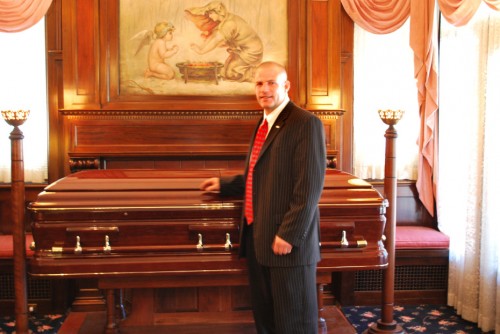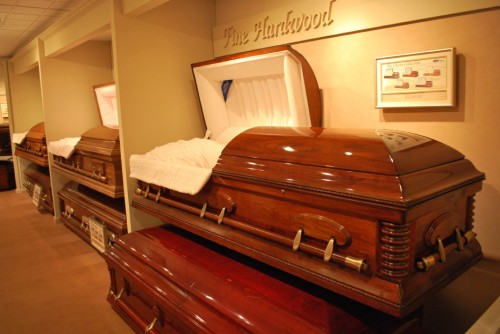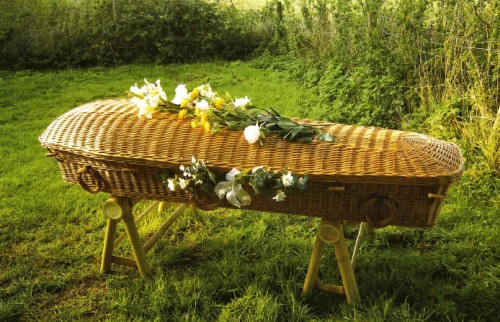Utah may have some of the highest longevity rates in the nation, but death still costs an arm and leg for most people
In case you are considering death in the near future, consider that the average cost of a funeral in Utah is $12,685. This is about one third of the average Utahn’s yearly salary. . . You might want to sleep on it.
by Heidi Grieser and Jacob Hodgen
No one ever said death was a party, but considering how much most funeral homes in Utah charge for their services, it seems like they ought to be throwing one in.

Spencer Larkin is the director of the Larkin Funeral Home, which has been operating in Utah for 125 years. Larkin provides services for mostly LDS clients. He says that typical funeral arrangements in Utah involve a vigil with an open casket viewing when possible, a chapel service, and then a graveside ceremony. While this is what most people consider normal, Larkin reports that perceptions are slowly starting to change.
“There’s been shift to cremation in the last 10 years.” He says that the change in views is a result of less religious stigma associated with cremation and the highly transient population of Utah. “We have a lot of people moving away and moving in,” Larkin says. “It’s just easier and faster to do cremation, and I think people hoped that by doing direct cremation they could avoid having to deal with the grief.”
Larkin also says that the way people handle cremation is changing, as people now incorporate more fluidly into the healing a funeral is meant to provide. “Direct cremation used to be detrimental to the grieving process. When you have a viewing with a cremation, what you are doing is inviting people to support you. If you don’t, you’ll end up going to the supermarket and seeing your neighbors, and at that point it will be something awkward that you kind of avoid dealing with.”

Another trend Larkin sees is, “People are trying to have these ‘celebrations,’ and not that you shouldn’t honor and celebrate the life, but just having an all out party can also be detrimental to the grieving process.”
“Rituals are an important part of grieving,” says Larkin. The baby boomer generation in particular is known for recognizing and embracing the funeral ceremony as meaningful, and this has led to very personalized services. Larkin offered this example: “We pallbeared a coffin up to a meadow in the Alta basin and had a service there. In another we had a little girl that died of leukemia. She loved princesses so we had everyone wear white gloves while touching the casket and all purple flowers.”
The National Funeral Directors Association (NFDA) conducts surveys among their members to gauge overall price trends in the industry and released this startling fact, “Looking at the historical data from 2006, the overall costs for funerals has risen by 11.4% since 2004, while the cost for caskets has risen by only 6.87%.” The NFDA associated the rising prices with the personalization trend, and found the highest rising funeral cost was for printing packages.
However, the conventional coffin and graveside service is a cultural tradition that is both relatively unique to the Western world and only one of many, many options.
Critics of the Funeral Industry Mortified at Misinformation
None of the usual burial practices in America is more controversial than embalming. In fact, when thought about rationally, it is pretty amazing people who fuss over cremation would ever even consider it.
Joyce Mitchell is the president of the Funeral Consumer’s Alliance of Utah. The FCA acts as a watchdog over the funeral industry and tries to better educate the public about their options. Mitchell says that there is a great need for it. “We as a people think that we are following millennia old traditions with embalming and burial, but we aren’t at all,” she tells me. “We are following a 100-year old tradition given by the funeral industry.”
Mitchell got started as a consumer advocate in the field after hearing numerous stories of people who were having to hold fundraisers for lavish funerals. “Don’t they know there are other options?” she asked. The answer, she says, is generally no. “People buy what they are told they need.”
Mitchell says it always surprises her how willing people are to consider embalming. “Most people are opposed to anything that would desecrate the body, but they don’t realize that embalming is highly invasive and generally involves piecing the organs, injecting the skin with dye, and flushing the body fluids down the toilet.”

According to the Funeral Consumer’s Alliance, embalming provides no public health benefit whatsoever. However, they claim many morticians are motivated to continue to perpetuate this myth, as it is such a lucrative business. The FCA says that embalming has no roots in Christian religion and is common only in the U.S. and Canada From an environmental perspective, embalming makes even less sense. Embalming chemicals are highly toxic. While licensed embalmers are required by law to wear a respirator mask and full-body covering while embalming, the chemicals themselves are not regulated and the waste is flushed into the public sewer system.
Mitchell says that if more people knew about their options, they wouldn’t be likely to chose embalming. “Wherever you have a predominance of religion, whatever people see others in their congregation doing becomes part of the religious practice. They don’t want to disrespect what others have done by doing something different. This is the case with funeral traditions in Utah.”
The notion that dead bodies pose an urgent health threat in the aftermath of a disaster is one of several enduring myths about disasters and relief efforts that the Pan American Health Organization (PAHO) and the World Health Organization (WHO) have been trying to counter for nearly two decades. The good news is that if you don’t like the idea of having your blood drained into the sewer system, there are lots of options.
Mitchell says that she has seen a growing trend in Utah towards “Green Burial” in the last 10 years. A green burial is one that abstains from chemicals or invasive procedures and allows for the body to decompose naturally in the ground. Such burials use simple, often handmade caskets and practitioners often obtain their own death certificate and perform viewings at home. Needless to say, this type of funerals costs a fraction of the cost of embalming and purchasing an opulent casket. “A green burial performed at home can be much more dignified and intimate than at a funeral home,” says Mitchell.
Whatever you do decide to do with your body, it’s worth thinking about ahead of time, especially if are willing to consider a more natural type of funeral, since your relatives might be wary of bucking current trends without your initial consent. Unless, of course, you want them to suffer.
There’s really no better way to get back at your kids for all those years of forgetting your birthday than leaving them without any last wishes and a 12 thousand dollar bill. Just be careful if you do: these are the kind of graves that get danced on.
Learn More:
For more information on options, contact the Funeral Consumer’s Alliance of Utah at www.fcaofutah.com.

